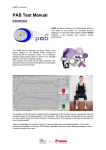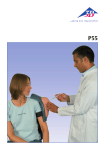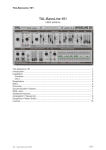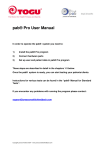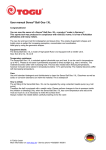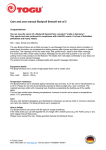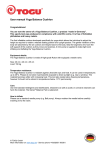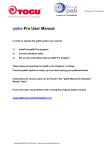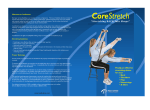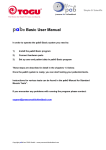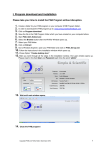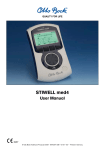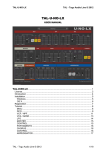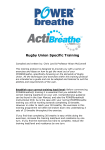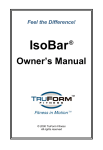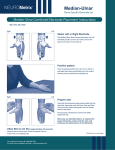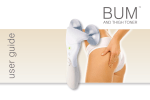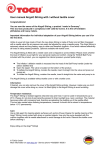Download pab® Test Manual
Transcript
PAB® Test Manual pab® Test Manual Introduction pab® stands for Pressure Air Biofeedback and is a very easy to use system for muscular function diagnosis. In connection with chosen inflated TOGU® products it can evaluate and measure muscle performance. pab The ® device measures the force, which a test person applies on an inflated TOGU product by measuring the air pressure inside. It is a dynamic strength measurement which is shown as a strength graph on the user’s computer screen. The duration of the test can be freely selected. This enables to test the maximum strength as well as fatigue performance of the muscles. The duration of the tests can be chosen freely. Depending on the duration one can assess the maximal strength as well as the fatigue pattern of the muscles. The testing results can be saved and compared for each patient during the whole training or therapy period. The progress of training and therapy can thus be documented. Tests for assessing the muscular function of various body parts are described below. This is not a conclusive compilation of all tests. pab® makes it possible to devise further testing procedures, just as it suites the need of the user. PAB® Test Manual Test Set up You can test a patient as soon as you have installed the pab® program and done all the necessary settings as described in the pab® Pro or pab® Basic User manual. The pab® device must be connected via USB cable with the computer. At the same time it must be connected to a TOGU training device by the tube with the inflator needle. The test instructions below explain for each standard test, which TOGU training device must be used. These are the TOGU training devices: TOGU Bodyroll Senso TOGU Senso Balance Kissen TOGU Throw Ring TOGU Senso Ball TOGU Dynair Ballkissen Senso Important! - Moisten the inflator needle before you insert it into the needle valve of the TOGU training device. Carefully insert the inflator needle straight (not at an angle) into the needle valve. The inflator needle must fit tight, without touching the material opposite of the needle valve. IMPORTANT! – Always remove inflator needle from TOGU training device after completion of muscle tests or training session. PAB® Test Manual Calibration before testing The test results are influenced by the air pressure inside the inflated TOGU training device. In order to compare various tests the initial air pressure must always be the same. Therefore it is recommended to always calibrate with an air pressure of 0 mbar. This can easily be achieved by following the steps below: 1) Moisten inflator needle and afterwards insert it with the tube into the needle valve. 2) Push blue ring (release valve) downwards and pull out the tube. Leave open for ± 5 seconds for air to equilibrate/calibrate. 3) Push tube back into needle attachment and pull on tube again to make sure tube is fitting tight into needle attachment. The calibration is done. The calibration value of 0 mbar means, that the air pressure inside the TOGU training device is equal to the air pressure outside of the device. PAB® Test Manual Neck 1 Neck Extension Test Assesses strength of the neck muscle extensors Equipment: pab® device, TOGU Senso Balance Kissen, small towel Muscles tested: Splenius capitis and cervicis, Longissimus capitis, Semispinalis capitis and cervicis, Subocciptal muscles Starting position Lie on back (knees bend) with back of head on TOGU Senso Cushion (if necessary, small towel can be folded under head). Arms crossed over chest (clench teeth slightly) Note: If you test a person on a bed, place a thin book under the TOGU Senso Cushion for a more firm test Movement description: Push head down on Senso Cushion End position: Similar to starting position Suggested Duration: 10 seconds hold Calibration: 0 mbar. See Simple Calibration on last page. Chest 2 Sit chest press test Assesses the combined chest strength of both Right & Left Chest Equipment: pab® device, TOGU Senso Ball Muscles tested: Pectoralis major muscle group, Coracobrachialis, Deltoid anterior, Biceps brachii Starting position Sit straight up on chair, hold Touch ball between palms of hands in front of chest, ball does not touch chest. Elbows are lifted sideways. Note: Try not to use fingers when doing press test. Movement description: Compress ball with palms of hands End position: Same as starting position Suggested Duration: 10 seconds hold Calibration: 0 mbar. See Simple Calibration on last page. PAB® Test Manual Shoulder Anterior Muscles 3 Empty can test Assesses elevation strength of the Rotator Cuff and anterior shoulder muscles Equipment: pab® device, TOGU Throwing ring with straps Muscles tested: Supraspinatus, Deltoid anterior & middle Starting position Sit on chair; lift straight arm in front to shoulder height; turn arm 30° outwards (palm faces downwards). Attach one side of strap around wrist and stand on a selected strap number (1, 2 or 3) on other strap for proper set up. Record numbers on straps for precise testing and re-testing. Movement description: Pull upwards against strap End position: Hand slightly higher than start position Suggested Duration: 10 seconds hold per arm Calibration: 0 mbar. See Simple Calibration on last page. Shoulder posterior muscles 4 Shoulder extension test Assesses extension-elevation strength of posterior shoulder and scapula muscles Equipment: pab® device, TOGU Muscles tested: Teres major, Latissimus dorsi, Deltoid posterior, Trapezius transversa, Deltoideus posterior, Trapezius, Rhomboideus major and minor Starting position Stand up straight, attach one side of strap around wrist (arm straight) and stand on a selected strap number (1, 2 or 3) on other strap. Palm of hand faces backwards. Hand pulls past buttocks. Tester can also stand on strap. Record numbers on straps for precise testing and re-testing. Movement description: Pull backwards and up against strap End position: Similar to starting position Suggested Duration: 10 seconds hold per arm Calibration: 0 mbar. See Simple Calibration on last page. PAB® Test Manual Hand 5 Hand Grip Test Assesses hand grip strength Equipment: pab® device, TOGU Bodyroll Senso Muscles tested: Finger Flexion: Flexor digitorum profundus, Flexor digitorum superficialis, Dorsal and Palmar interossei, Flexor digiti minimi, Thumb Flexion: Flexor pollicus brevis, Flexor pollicus longus, Adductor pollicis Starting position Sit on chair, elbows bent to 90°, take two (2) Bodyroll Senso (Air Grips) in hands. Air Grips is in vertical position. Note: You can use 1 or 2 Air grips to test grip strength. Movement description: Hand grip squeeze End position: Same as starting position Suggested Duration: 10 seconds hold per hand Calibration: 0 mbar. See Simple Calibration on last page. 6 Finger Grip Test Assesses individual finger grip strength Equipment: pab® device, TOGU Bodyroll Senso Muscles tested: Finger Flexion: Flexor digitorum profundus, Flexor digitorum superficialis, Dorsal and Palmar interossei, Flexor digiti minimi, Thumb Flexion: Flexor pollicus brevis, Flexor pollicus longus, Adductor pollicis Starting position Sit on chair, elbow bend to 90°, take Air Grip between index finger and thumb. Air Grip is in vertical position and gently rests on palm of other hand.. Note: Middle, ring and small fingers can be tested in the same way Movement description: Finger grip squeeze End position: Same as starting position Suggested Duration: 10 seconds hold per finger Calibration: 0 mbar. See Simple Calibration on last page. PAB® Test Manual Arms 7 Tricepts Extensions Test Assesses triceps extension strength Equipment: pab® device, TOGU Senso Balance Kissen, small towel Muscles tested: Triceps brachii, Anconeus Starting position Sit on chair, elbow bend to 90°. Place side of hand on top of TOGU Senso Cushion (thumb facing upwards). Other hand gently supports side of cushion. Movement description: Push downwards on Senso Cushion End position: Same as starting position Suggested Duration: 10 seconds hold per arm Calibration: 0 mbar. See Simple Calibration on last page. 8 Biceps Curl Test Assesses biceps curl strength Equipment: pab® device, TOGU Throwing ring with straps Muscles tested: Biceps brachii, Brachialis Starting position Stand up straight. Elbow bend to 90° and tucked into side (palm point up). Attach one side of strap around wrist and stand on a selected strap number (1, 2 or 3) on other strap for proper set up. Record numbers on straps for precise testing and re-testing. Movement description: Upwards pull against strap End position: Hand slightly higher than starting position Suggested Duration: 10 seconds hold per arm Calibration: 0 mbar. See Simple Calibration on last page. PAB® Test Manual Hips 9 STANDING HIP EXTENSION TEST Assesses the hip extensor strength of each hip Equipment: pab® device, TOGU Throwing ring with straps Muscles tested: Gluteus maximus, Gluteus medius and minimus posterior part, Piriformis, Adductor magnus, Biceps femoris (long head), Semimembranosus, Semitendinosus. Starting position Stand and lean forward on chair/desk with both hands. Attach one side of strap around ankle and stand on strap number 1, 2 or 3 with other foot. A ±45⁰ angle must be formed between legs (see photo). Record numbers on straps for precise testing and re-testing. Movement description: Push back against strap, straight leg End position: Same as starting position – hip extension position Suggested Duration: 10 seconds hold per leg Calibration: 0 mbar. See Simple Calibration on last page. 10 STANDING HIP ABDUCTION TEST Assesses the hip abductor strength of each hip Equipment: pab® device, TOGU Throwing ring with straps Muscles tested: Gluteus medius and minimus, Gluteus maximus (upper fibres), Tensor fasciae latae, Piriformis, Sartorius. Starting position Stand up straight, hands on wall (arms bend slightly), attach one side of strap around ankle and stand on a selected strap number 1, 2 or 3 on other strap with other foot for proper set up. A ±45⁰ angle must be formed between legs (see photo). Record numbers on straps for precise testing and re-testing. Movement description: Push sideway against strap, straight leg End position: Same as starting position - hip abduction position Suggested Duration: 10 seconds hold per leg Calibration: 0 mbar. See Simple Calibration on last page. PAB® Test Manual Knee 11 KNEE EXTENSION TEST (CLOSE KINETIC CHAIN) Assesses knee extension (Quadriceps) strength Equipment: pab® device, TOGU Senso Ball Muscles tested: Quadriceps femoris muscles Starting position Client sits on bed/floor, with one Touch ball under knee and foot pushing against other Touch ball, against tester. Client holds sides of bed. Air pressure is measured in Touch ball under the knee. Movement description: Squeeze knee downwards on Touch ball while foot pushes against other Touch ball against tester. Tester firmly holds down ankle of client. End position: Knee is straighter than starting position Suggested Duration: 10 seconds hold per leg Calibration: 0 mbar. See Simple Calibration on last page. 12 KNEE EXTENSION TEST (OPEN KINETIC CHAIN) Assesses knee extension (Quadriceps) strength Equipment: pab® device, TOGU Throwing ring with straps Muscles tested: Quadriceps femoris muscles Starting position Client sits on edge of bed, attach one side of strap around ankle, knee extended to ±45⁰. Tester stands on a selected strap number (1, 2 or 3) on other strap for proper set up. Record numbers on straps for precise testing and re-testing.. Movement description: Push up (knee extension) against strap at ±45⁰ of knee flexion End position: Knee is slightly straighter than starting position Suggested Duration: 10 seconds hold per leg Calibration: 0 mbar. See Simple Calibration on last page. PAB® Test Manual 13 KNEE EXTENSION TEST (OPEN KINETIC CHAIN) Assesses knee flexion (Hamstring) strength Equipment: pab® device, TOGU Throwing ring with straps Muscles tested: Biceps femoris, Semitendinosus, Gracilis, Gastrocnemius Semimembranosus, Sartorius, Popliteus, Starting position Standing up straight, with both hands on wall, attach one side of strap around ankle while knee is flexed at ±45⁰. Stand on a selected strap number 1, 2 or 3 on other strap with other foot (heel) for proper set up. Record numbers on straps for precise testing and re-testing. Movement description: Bend knee and pull up against strap End position: Knee more bent than starting position Suggested Duration: 10 seconds hold per leg Calibration: 0 mbar. See Simple Calibration on last page IMPORTANT! – Always remove inflator needle from TOGU training device after completion of muscle tests or training session.










